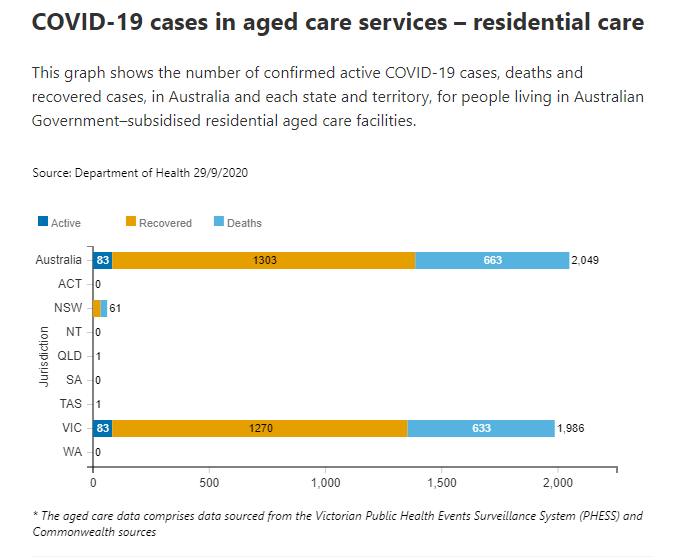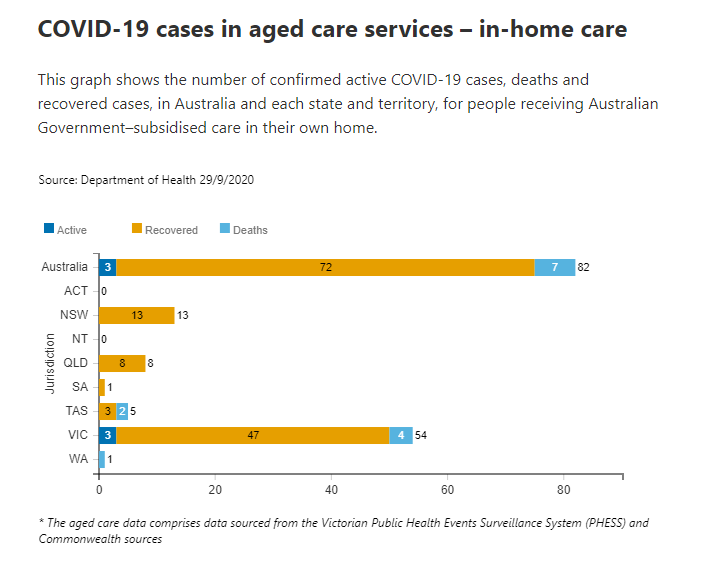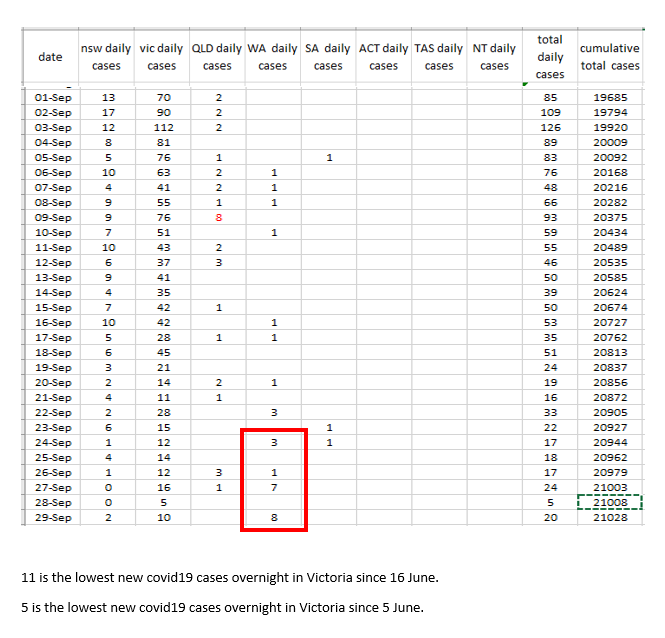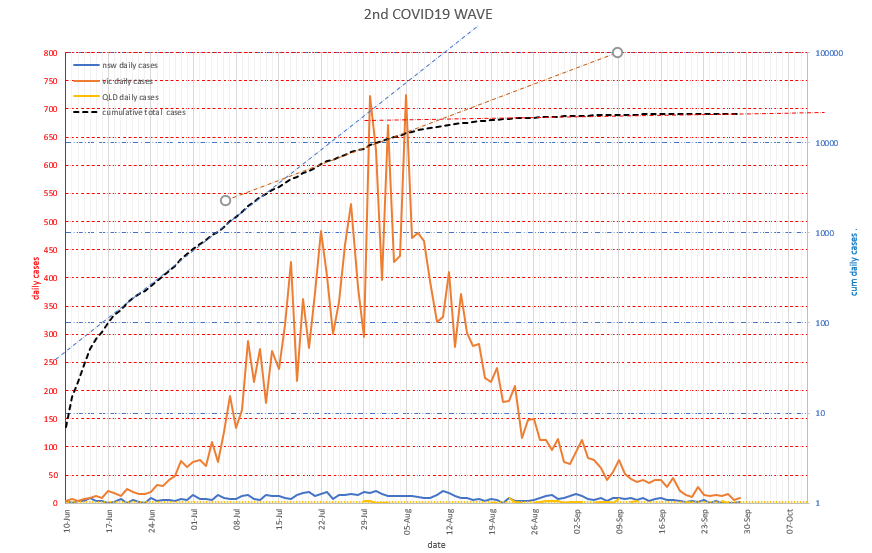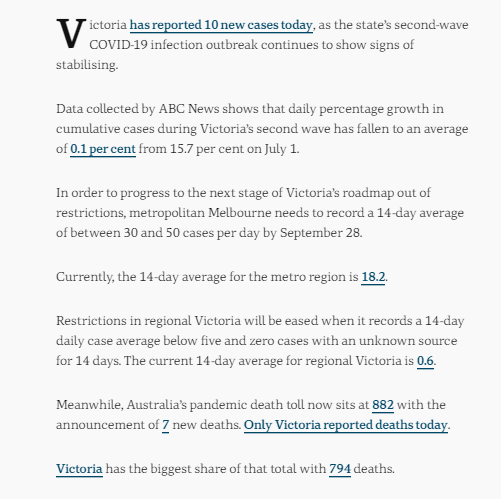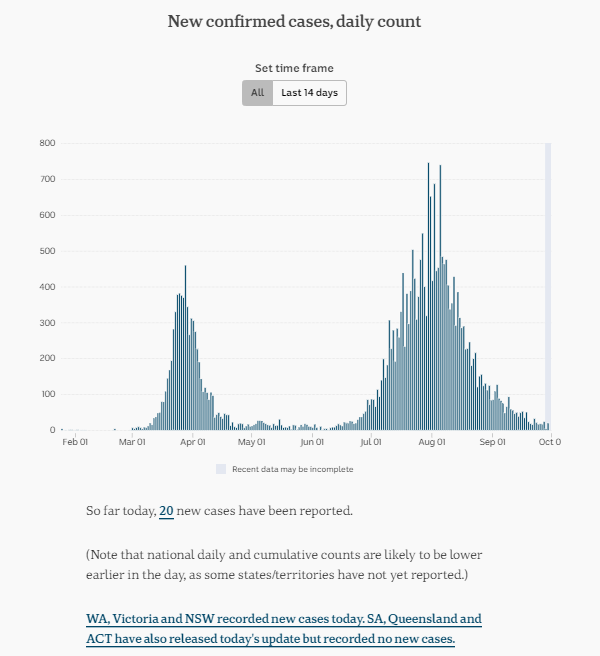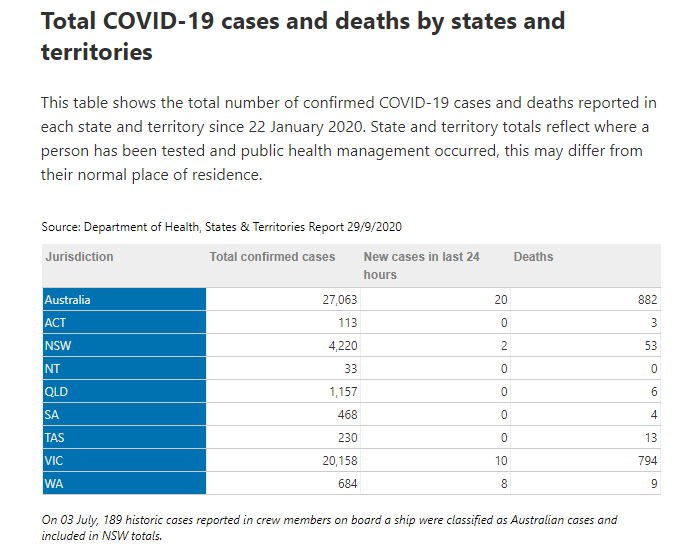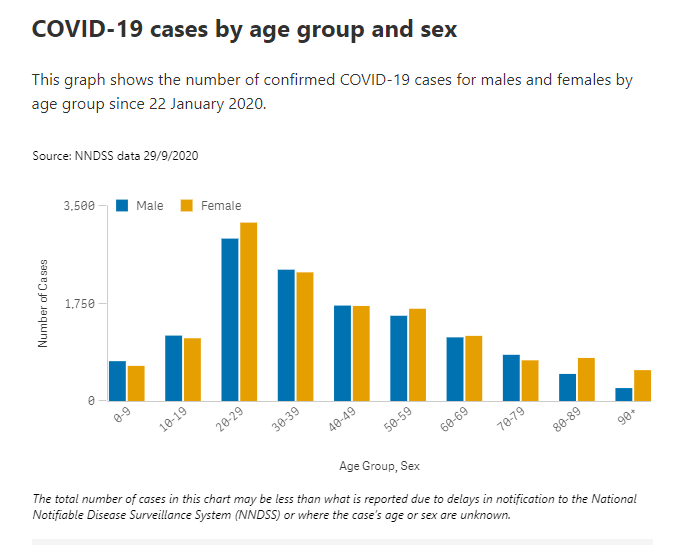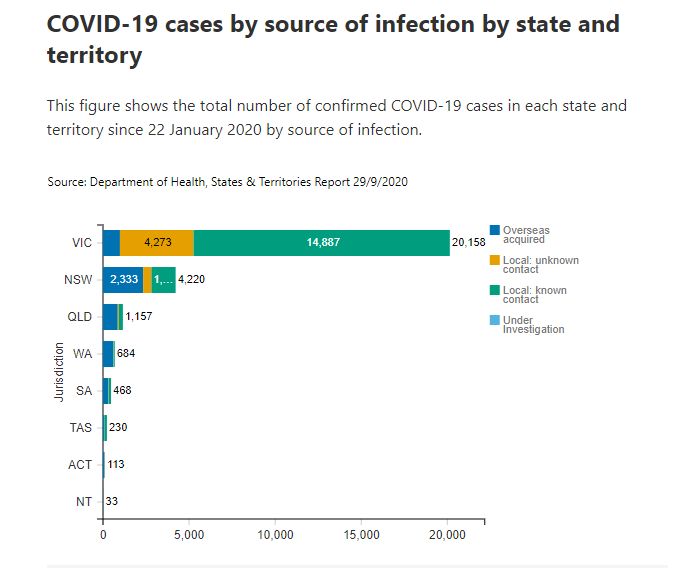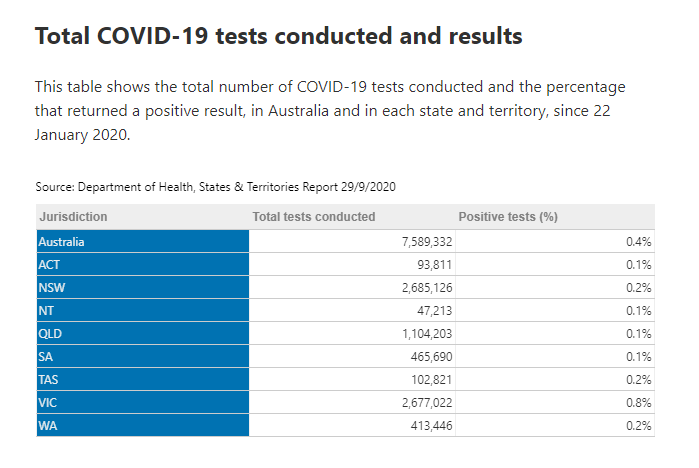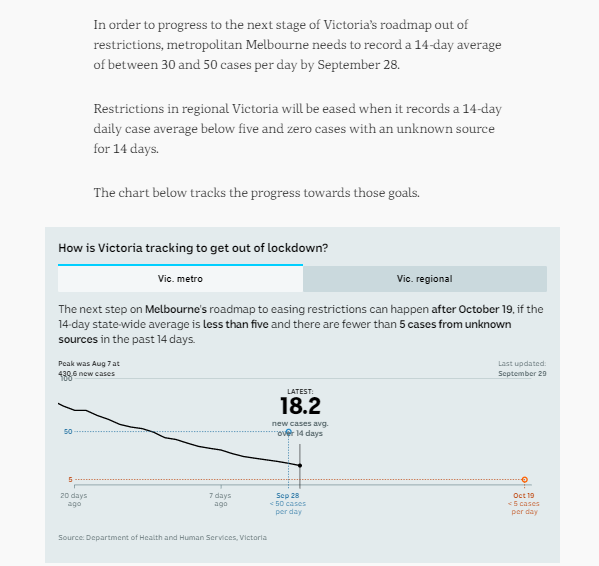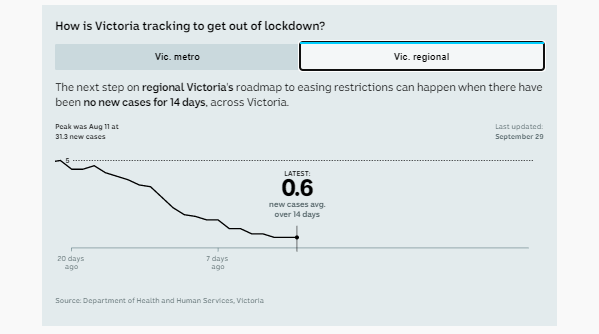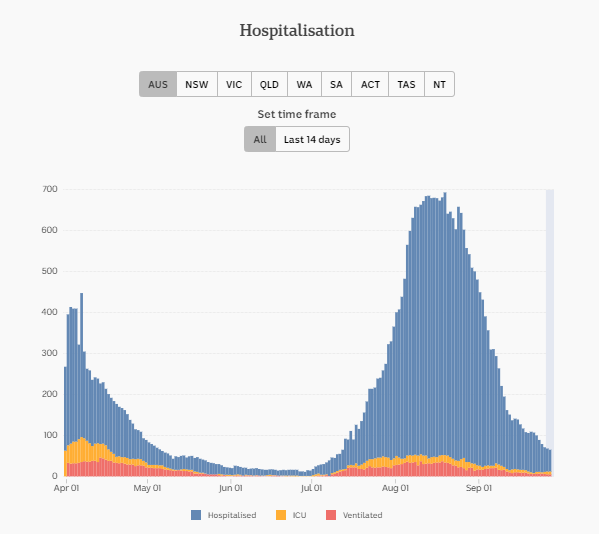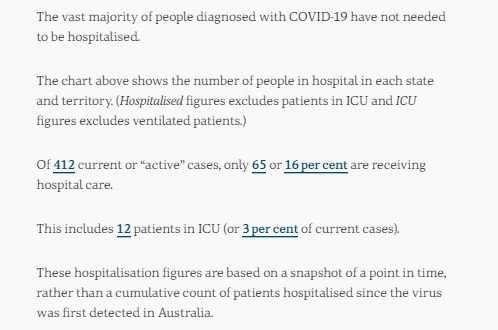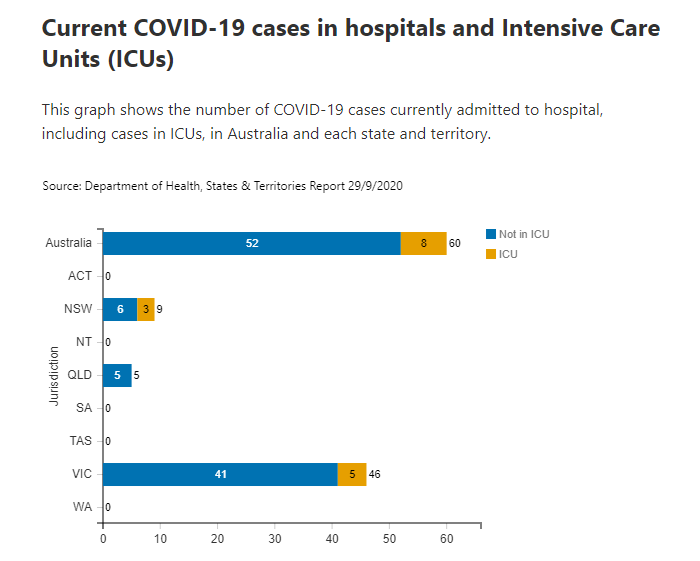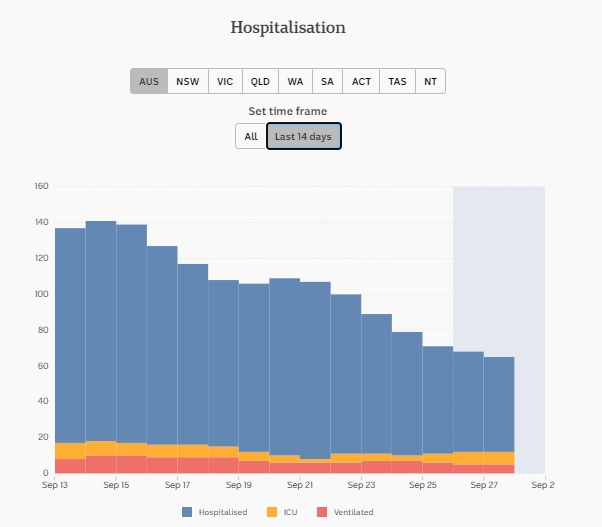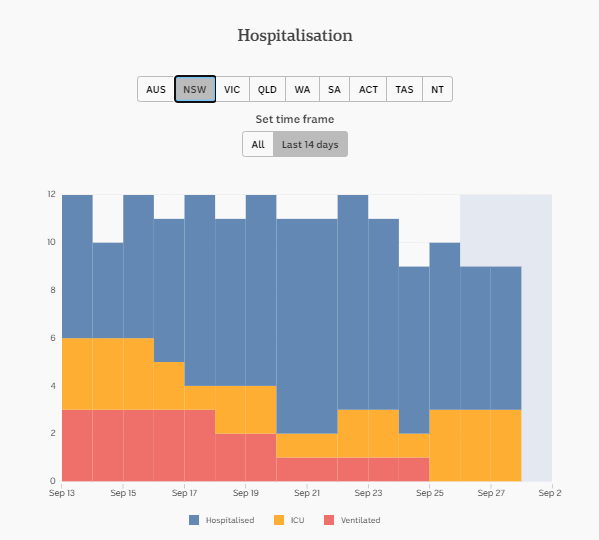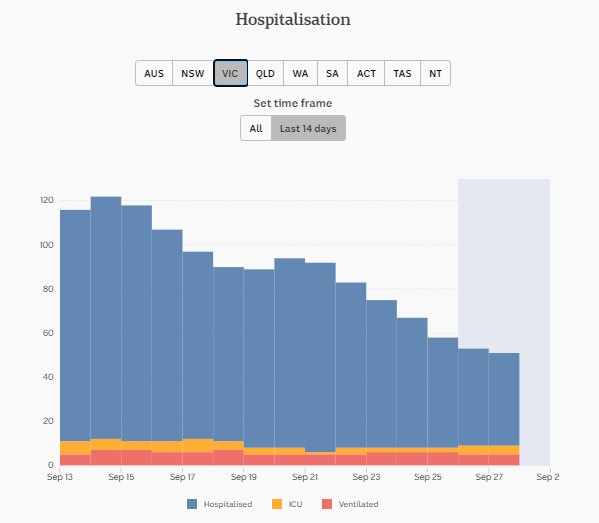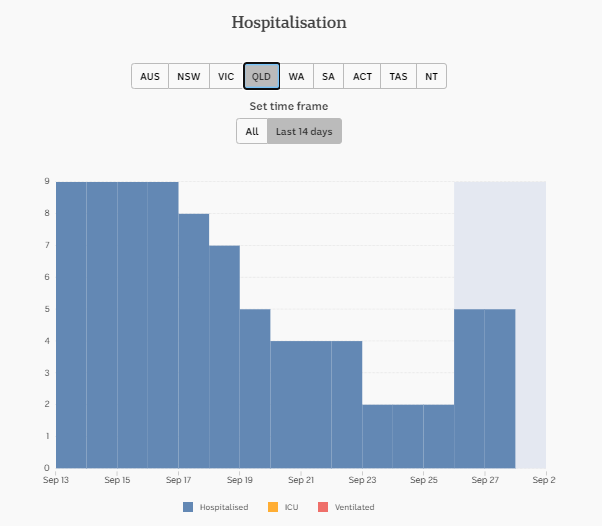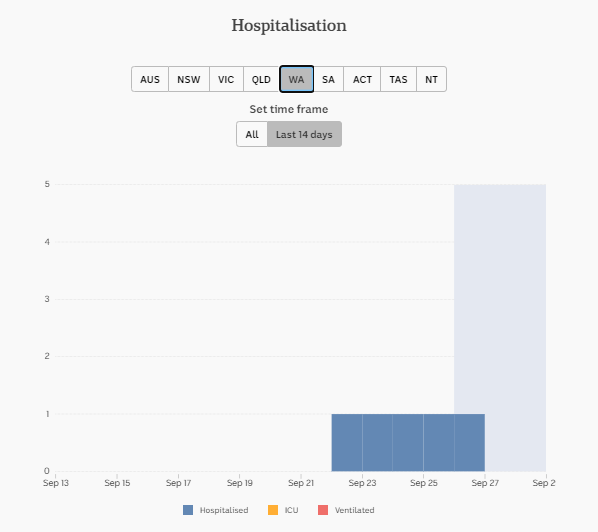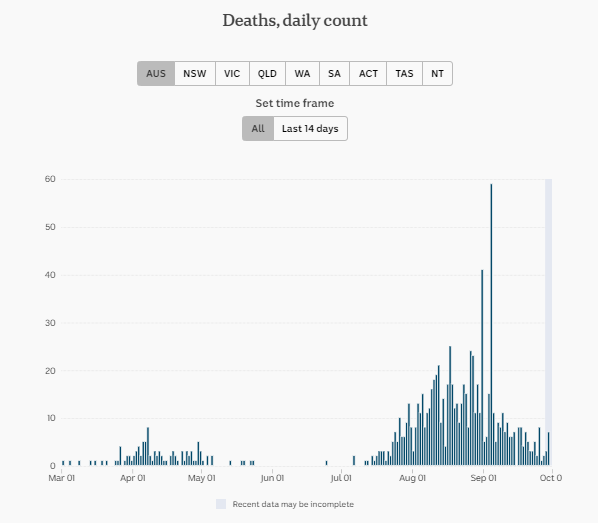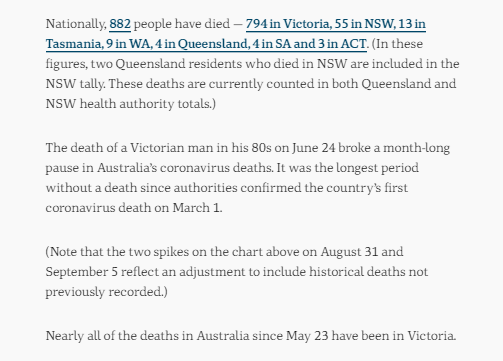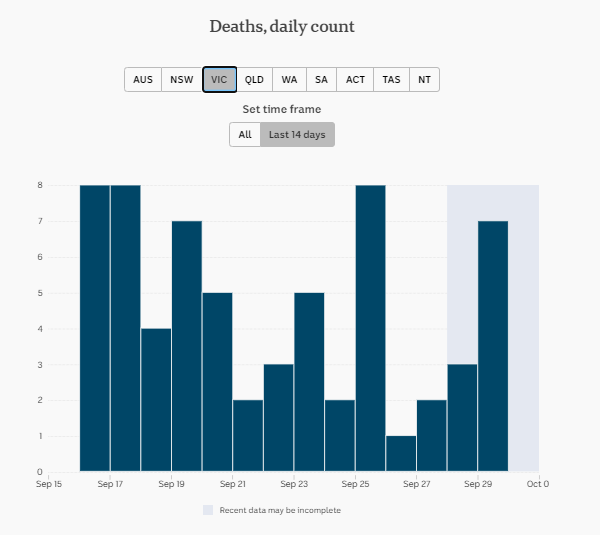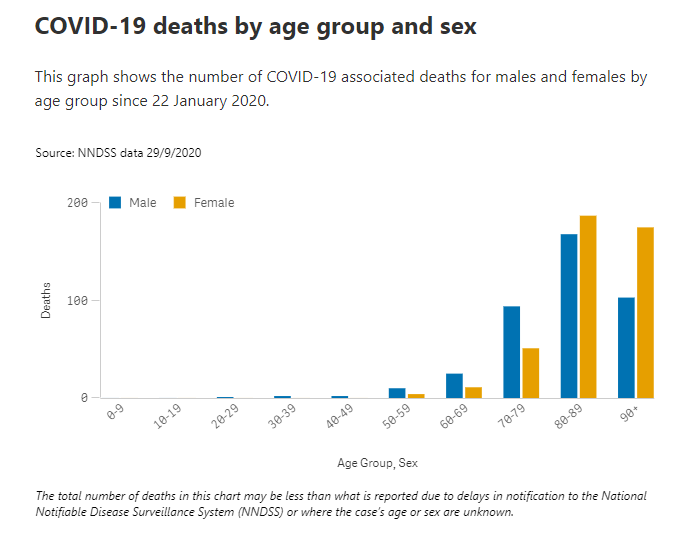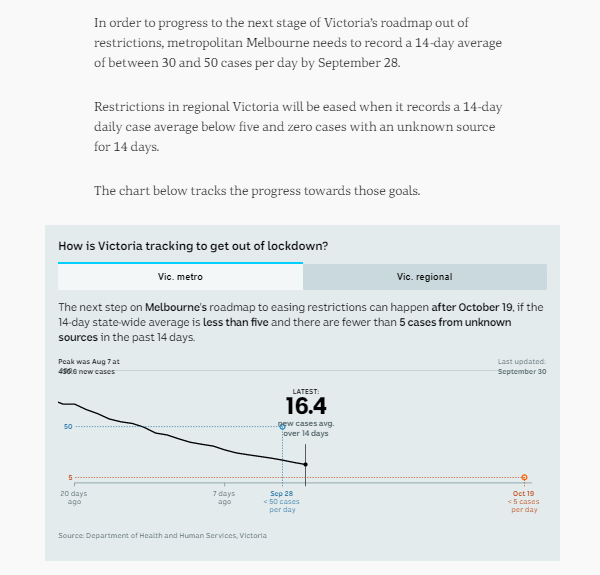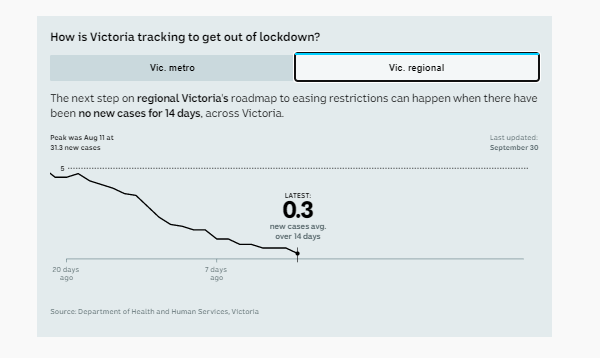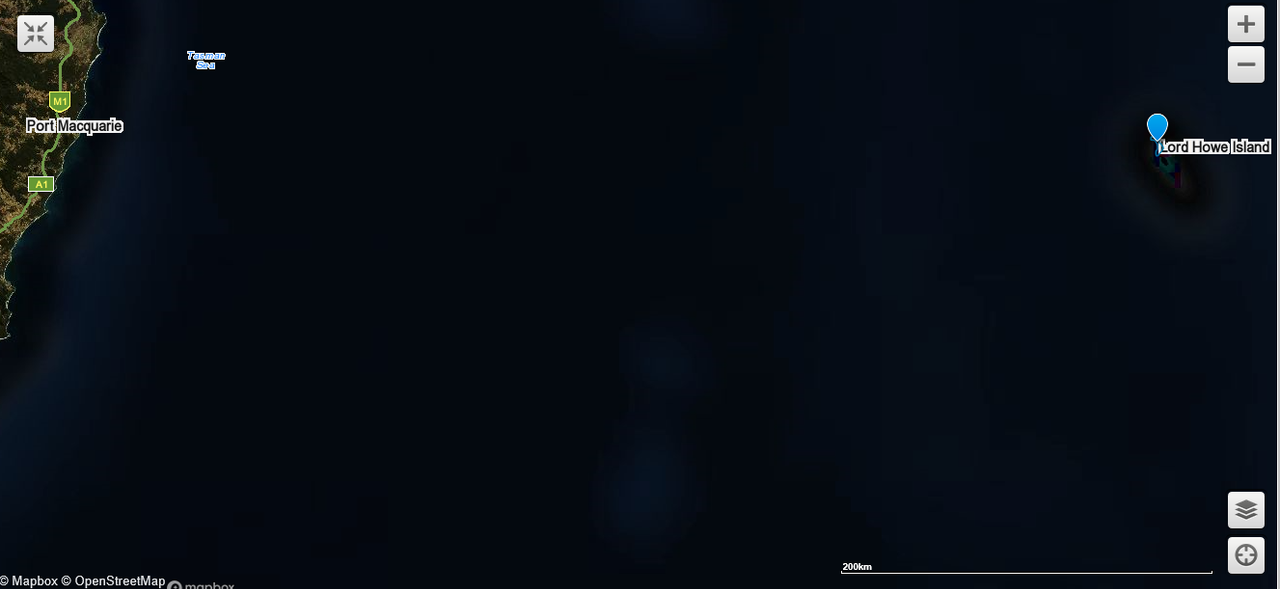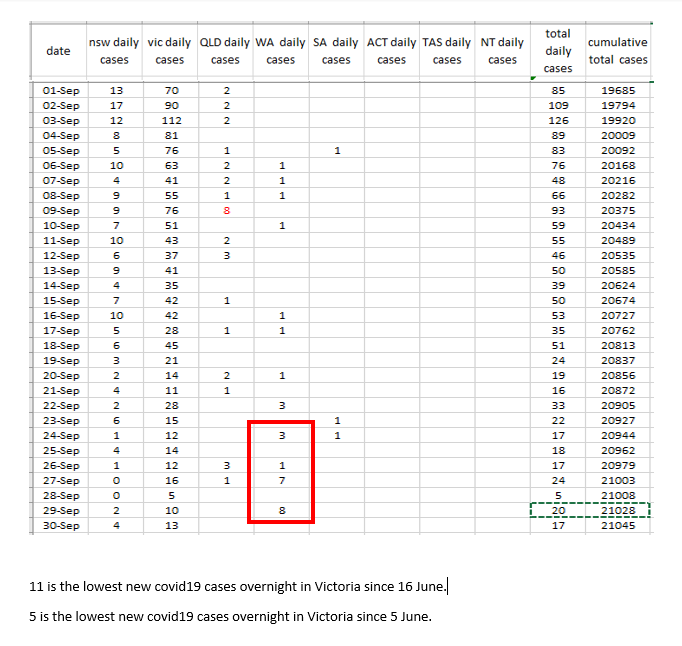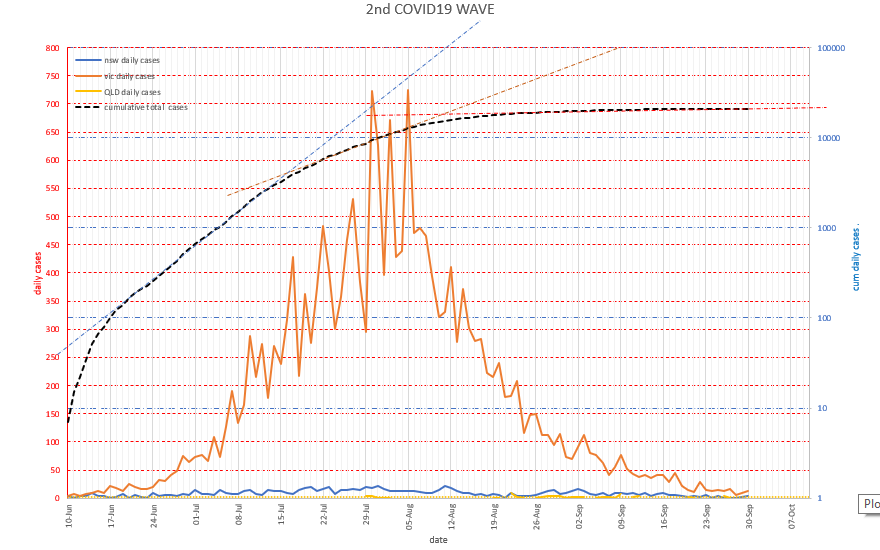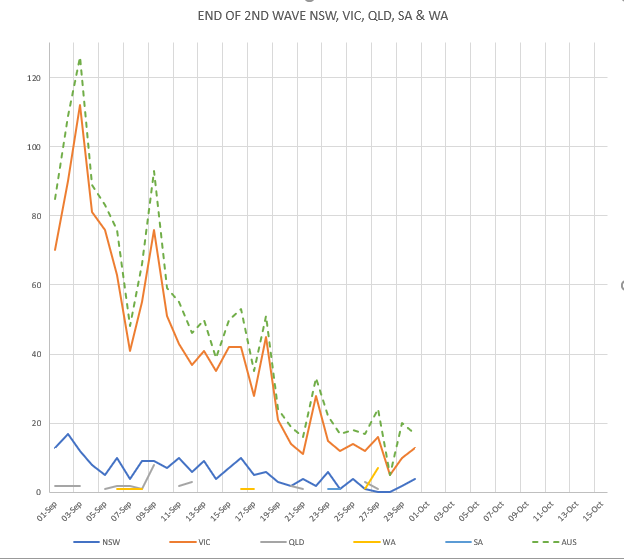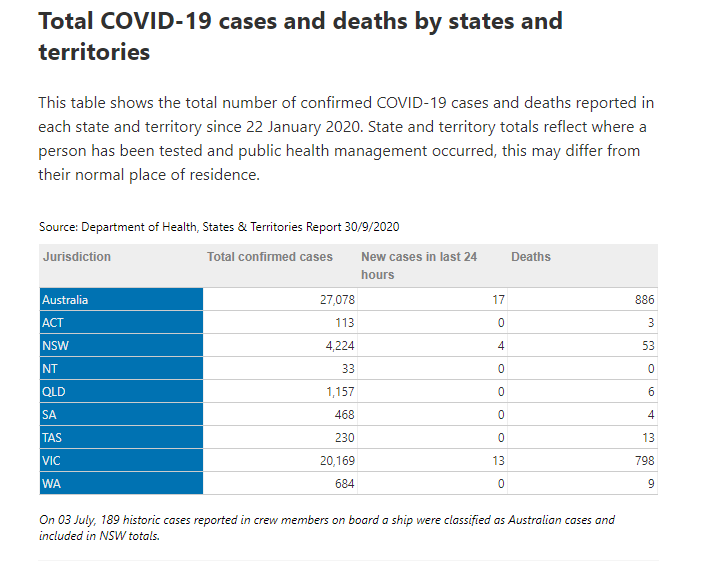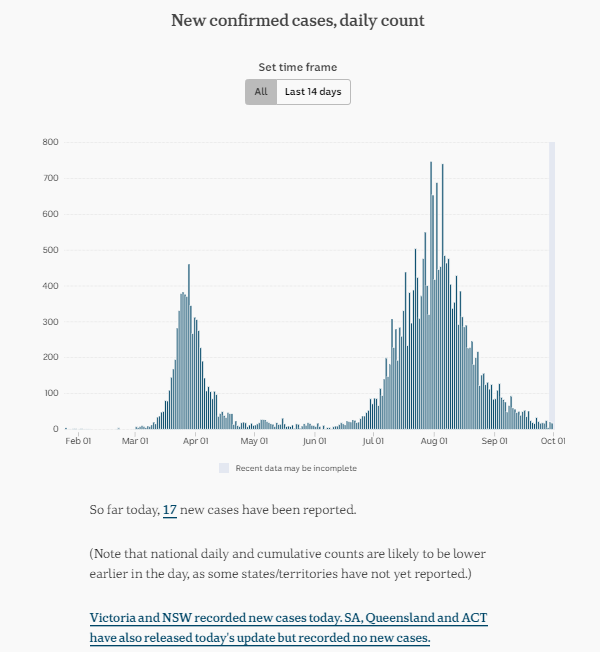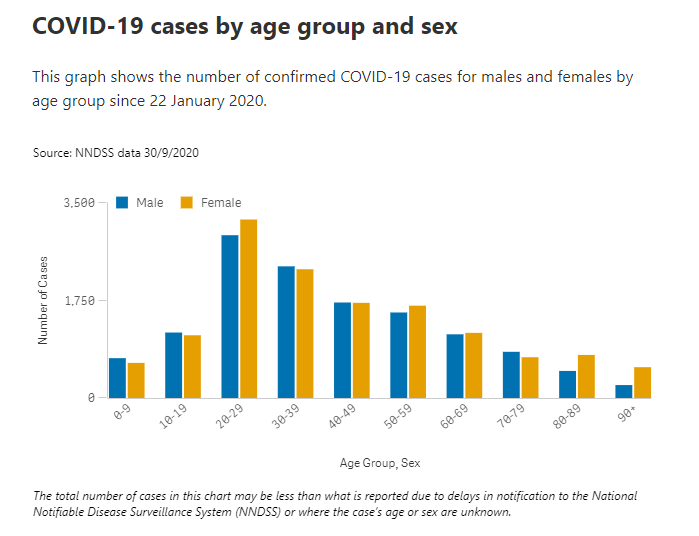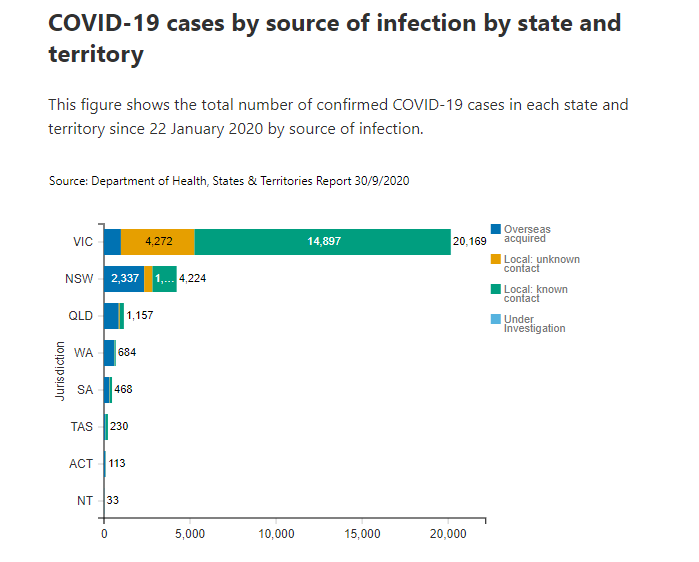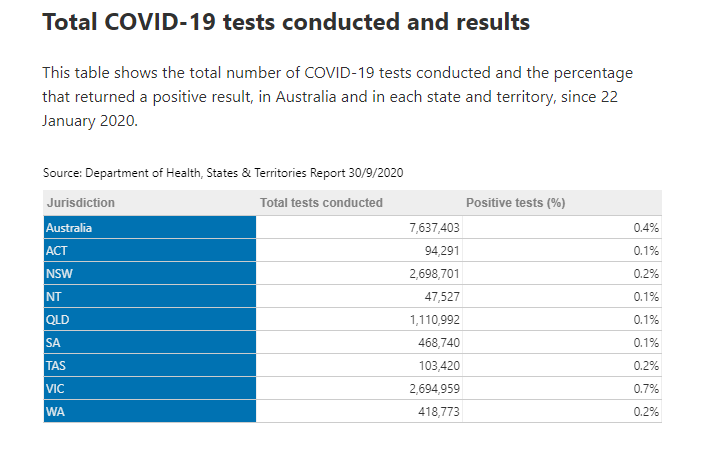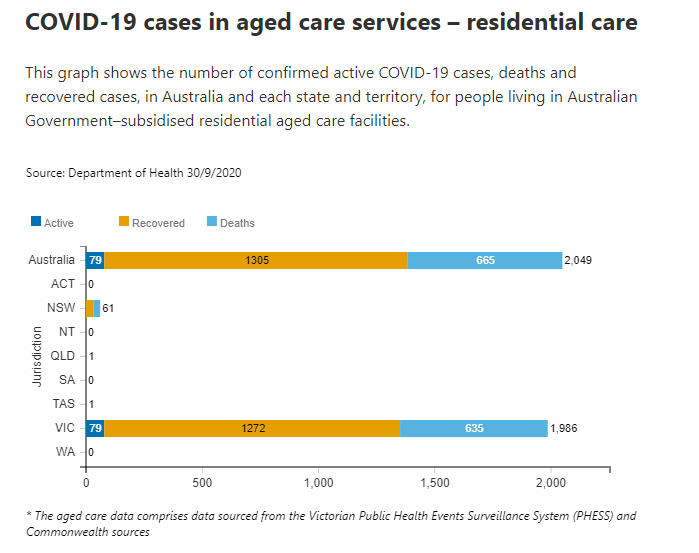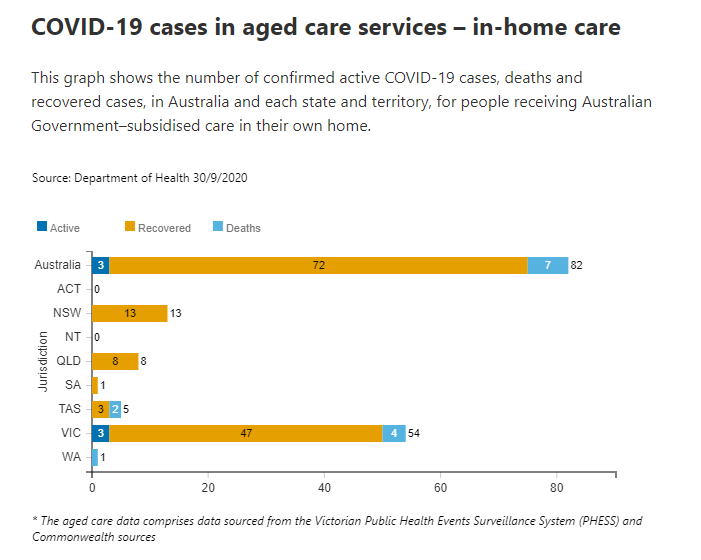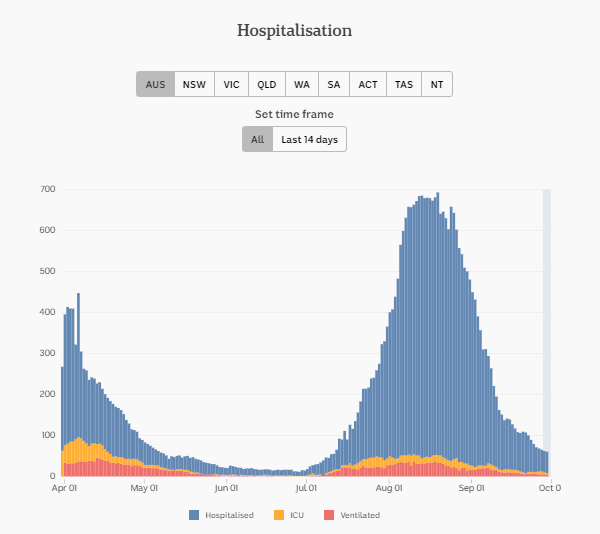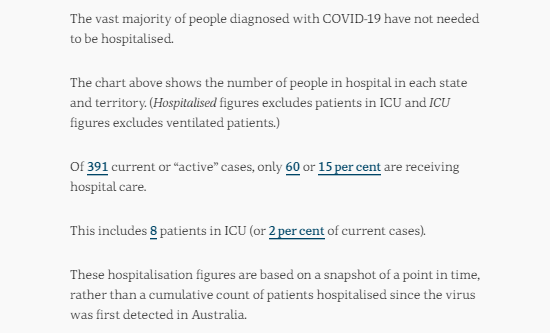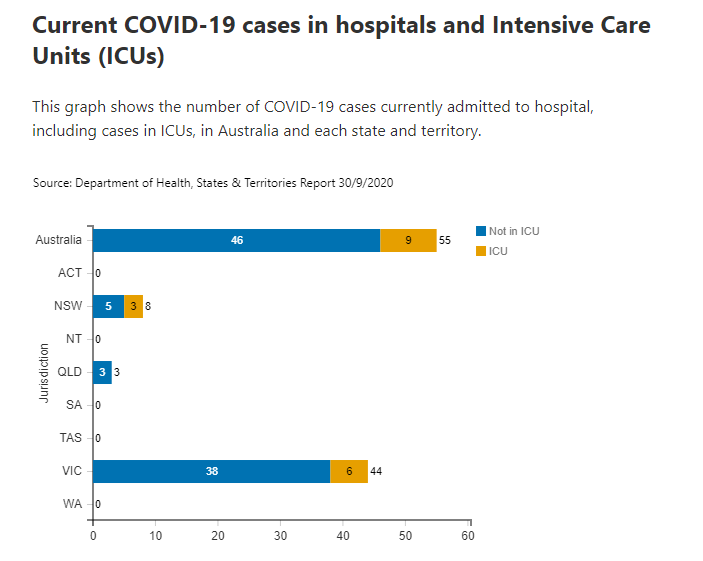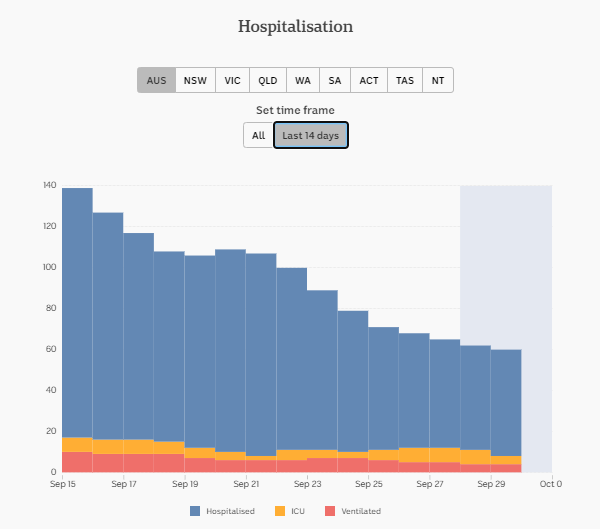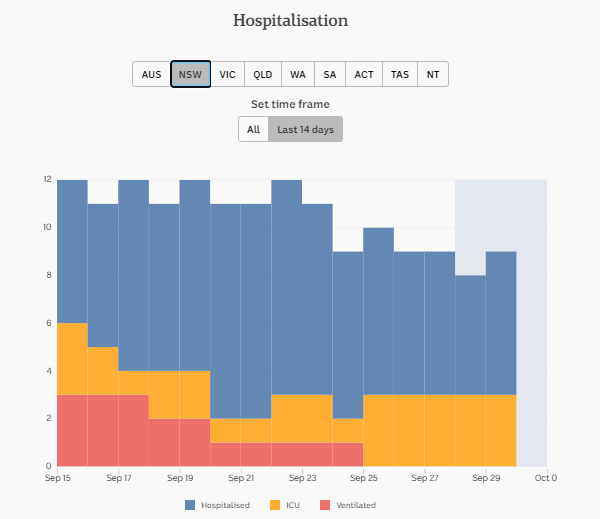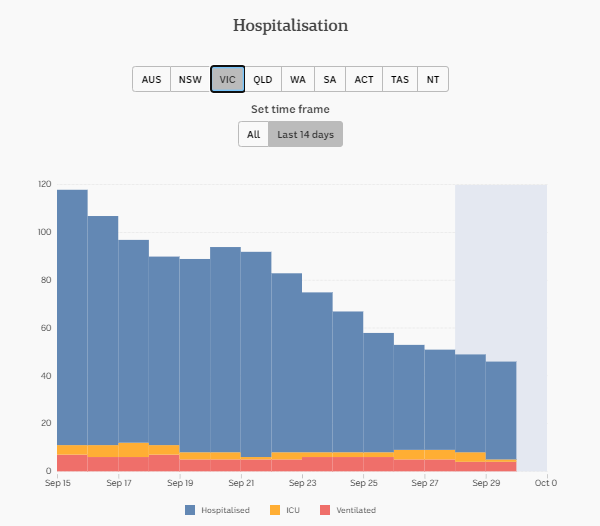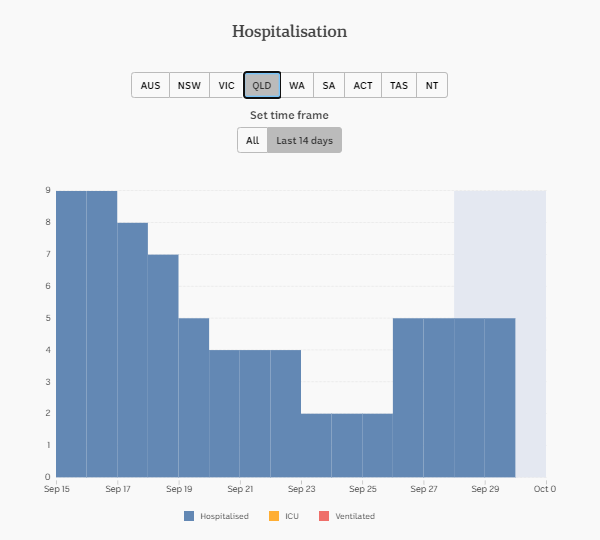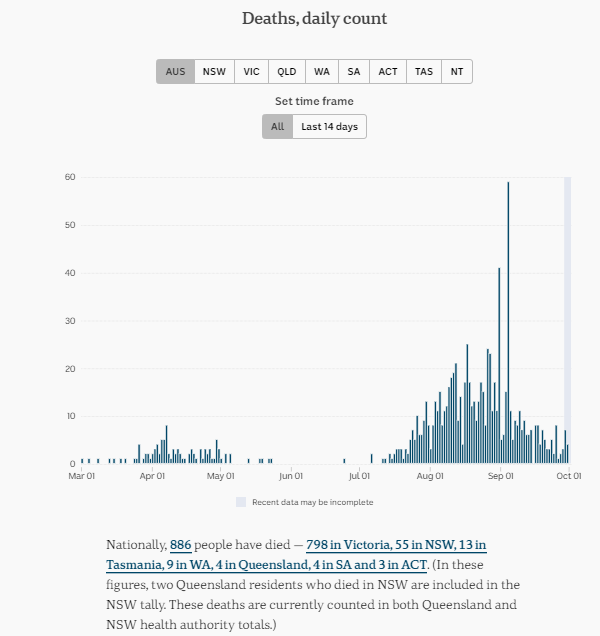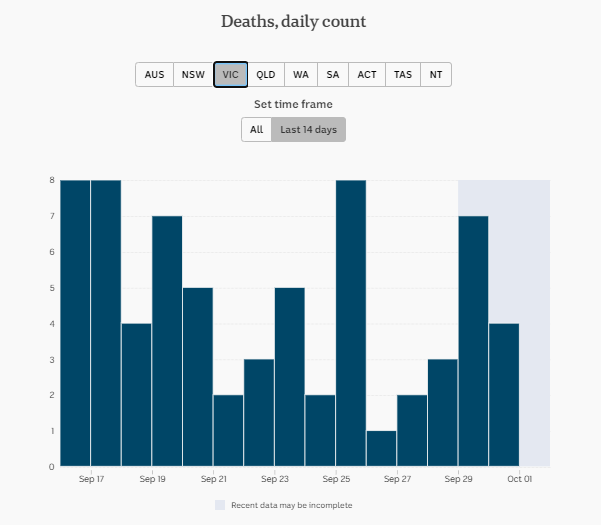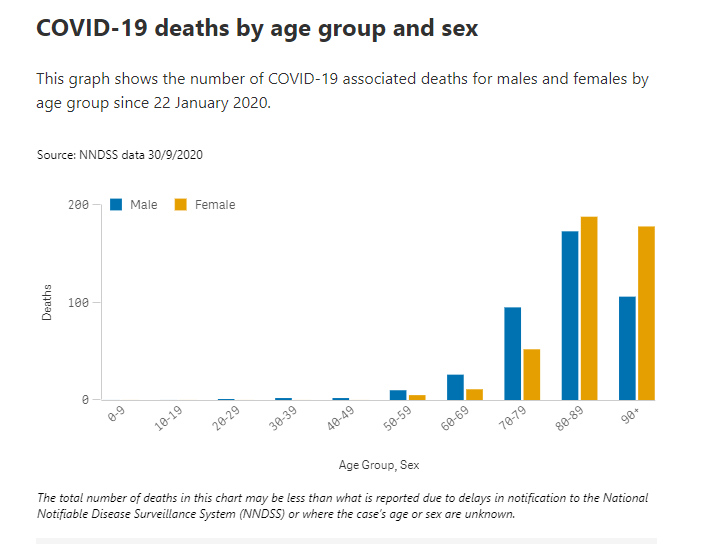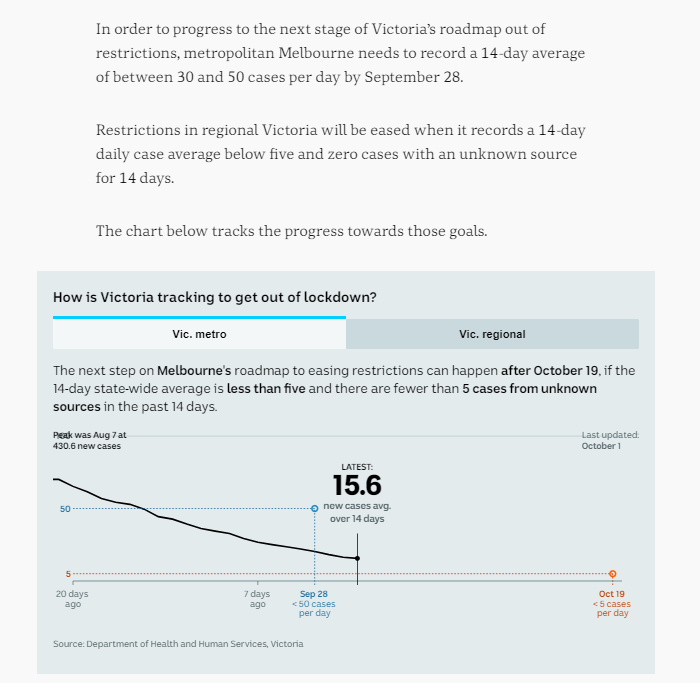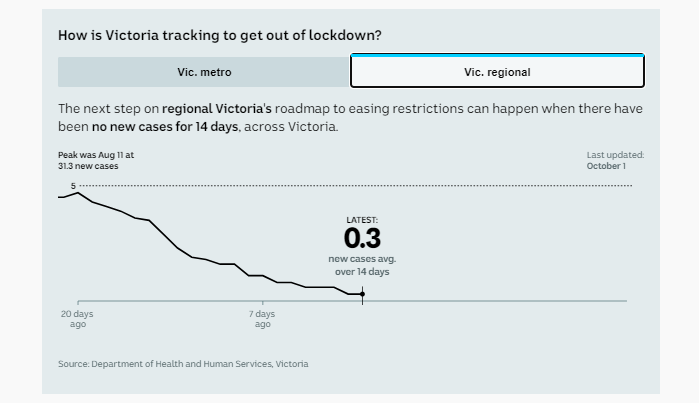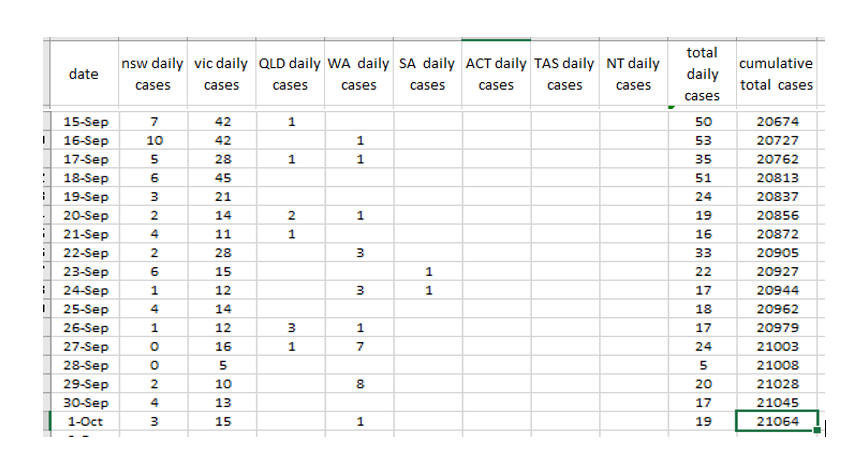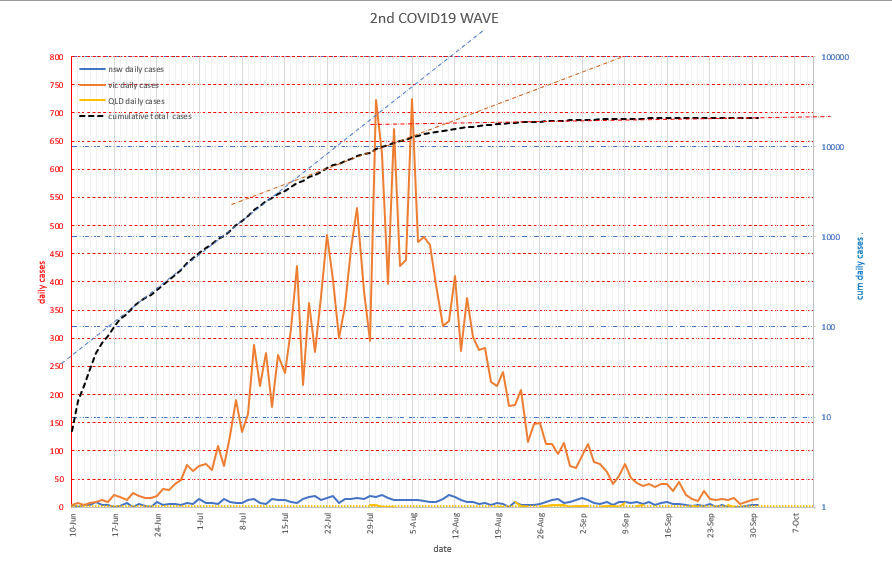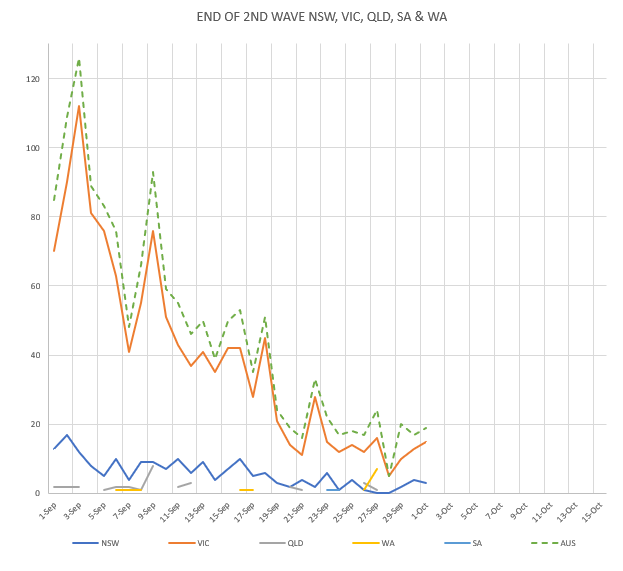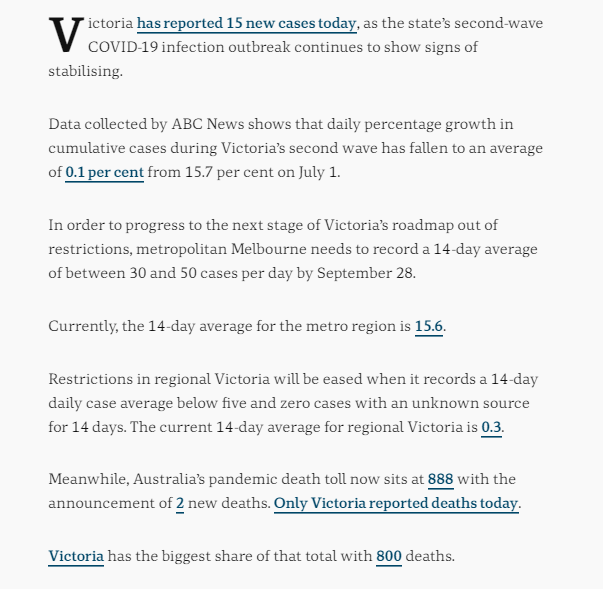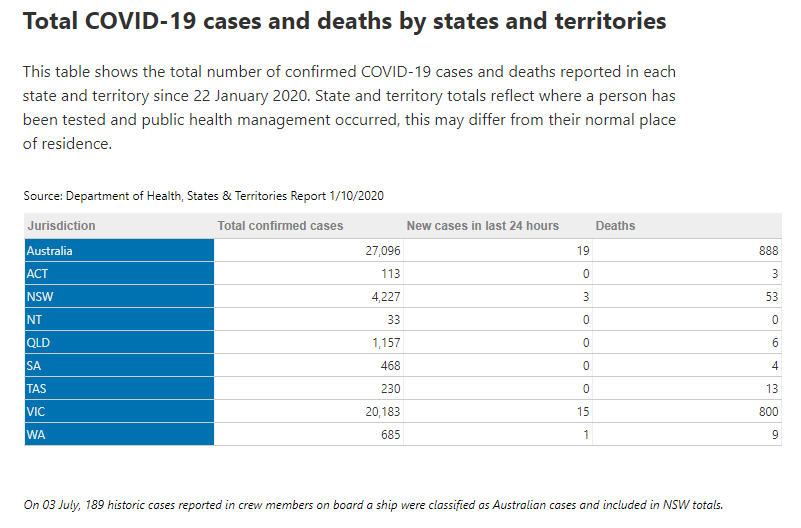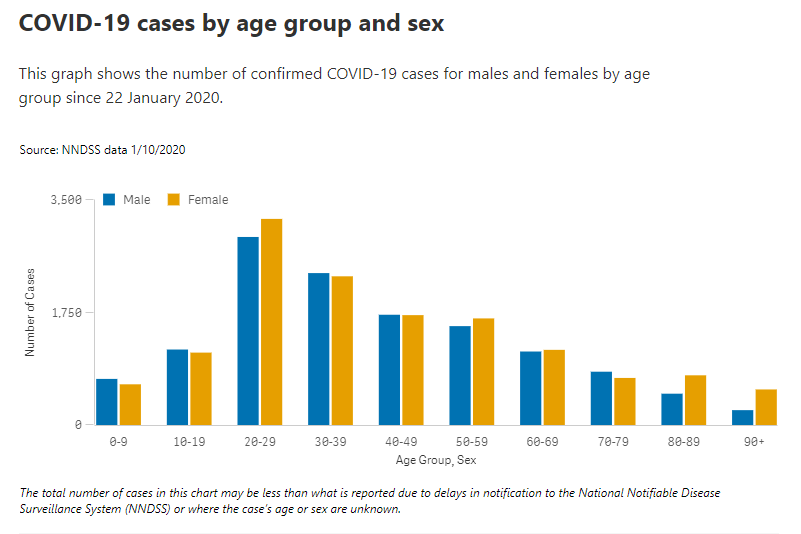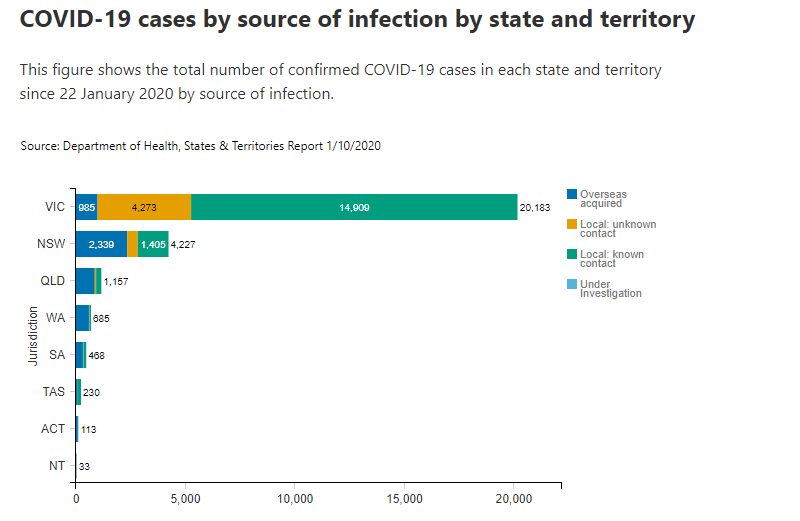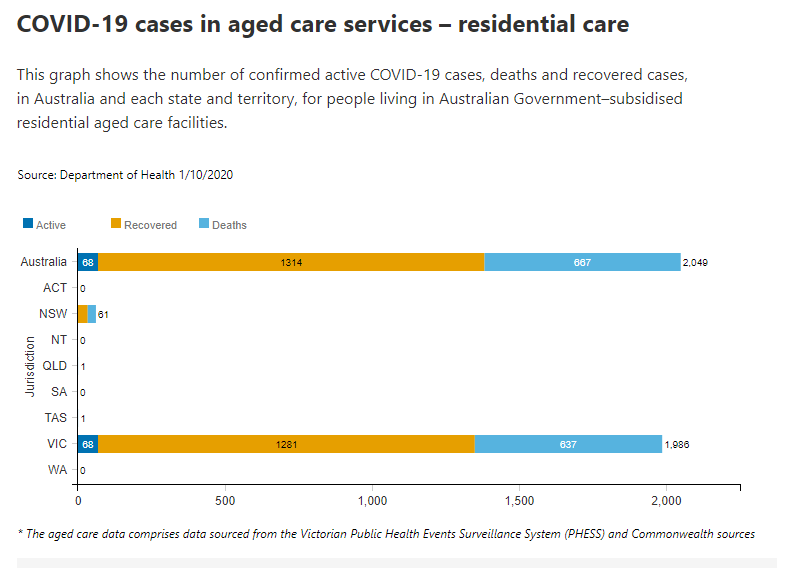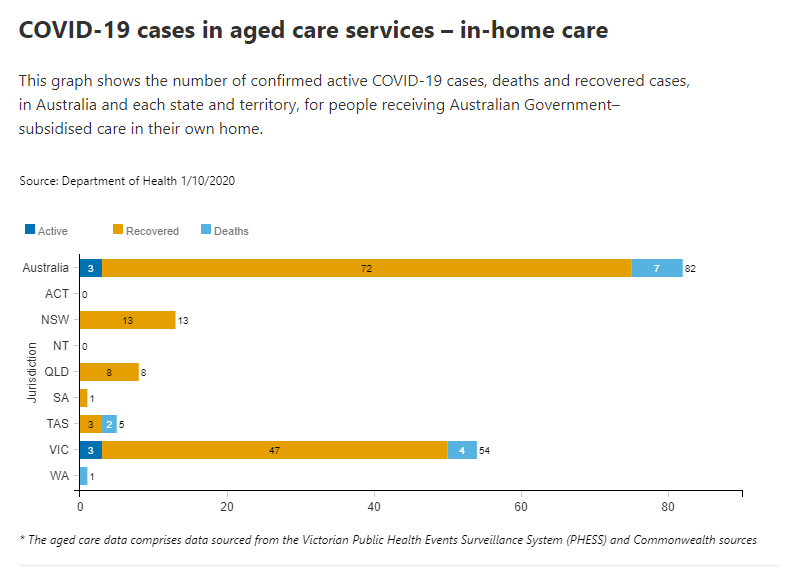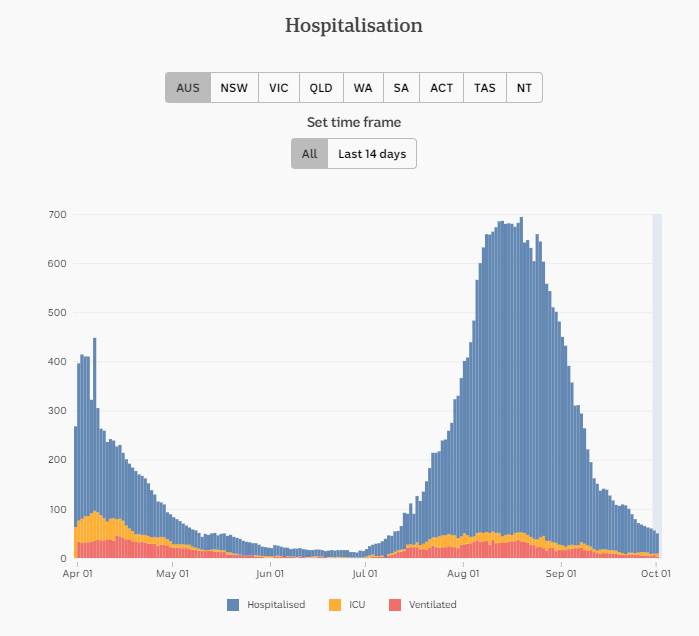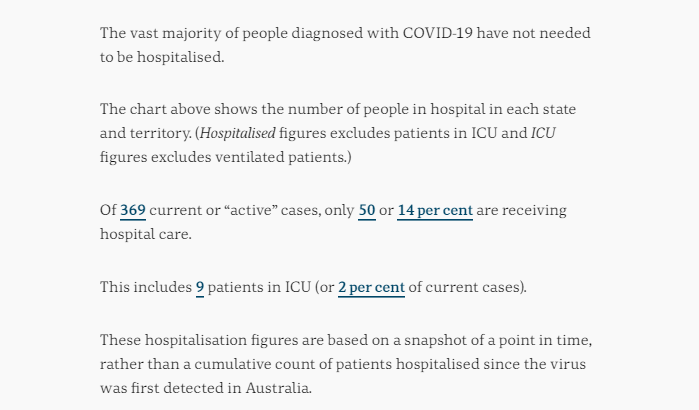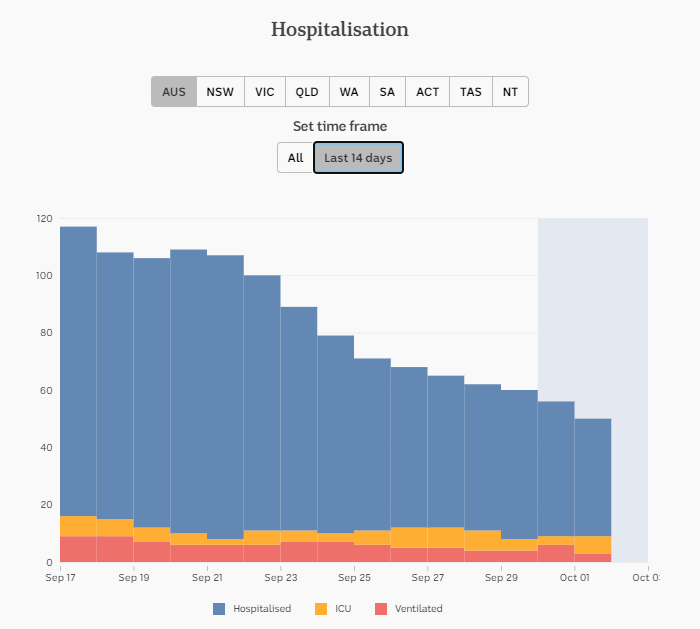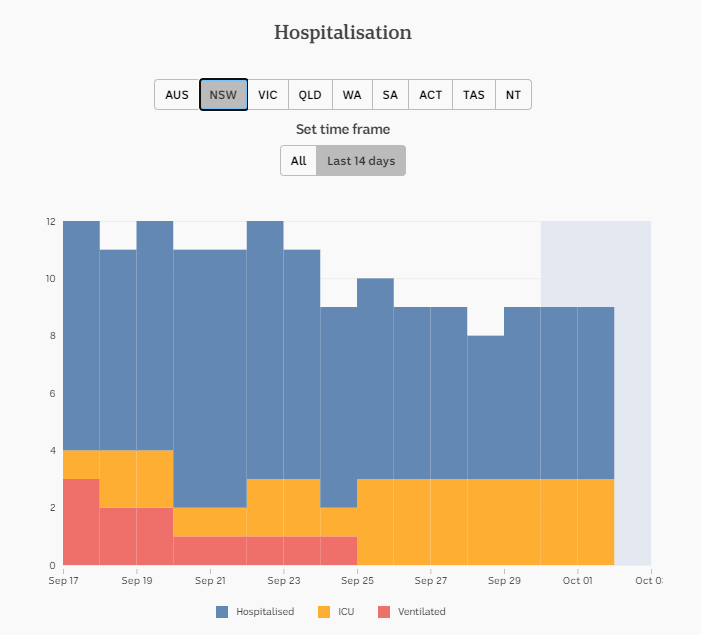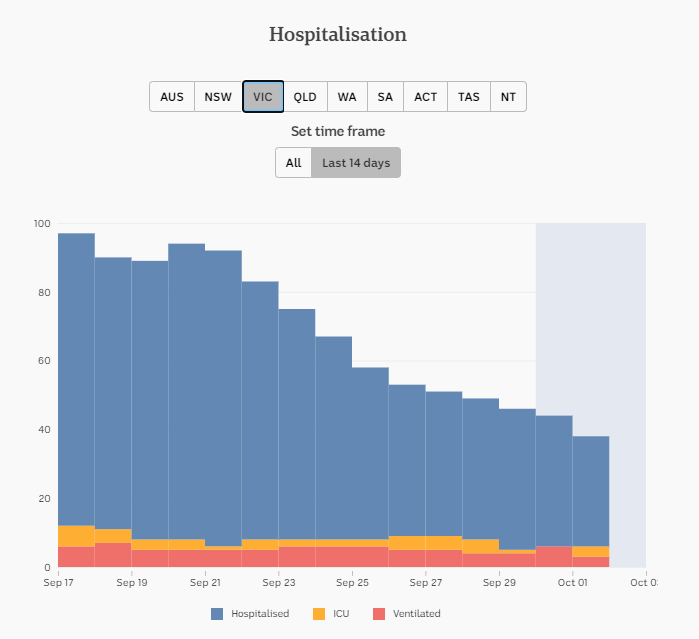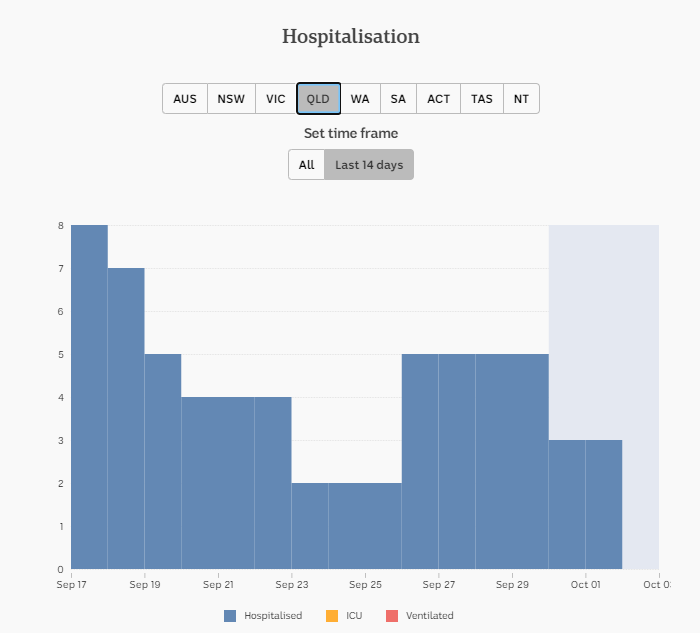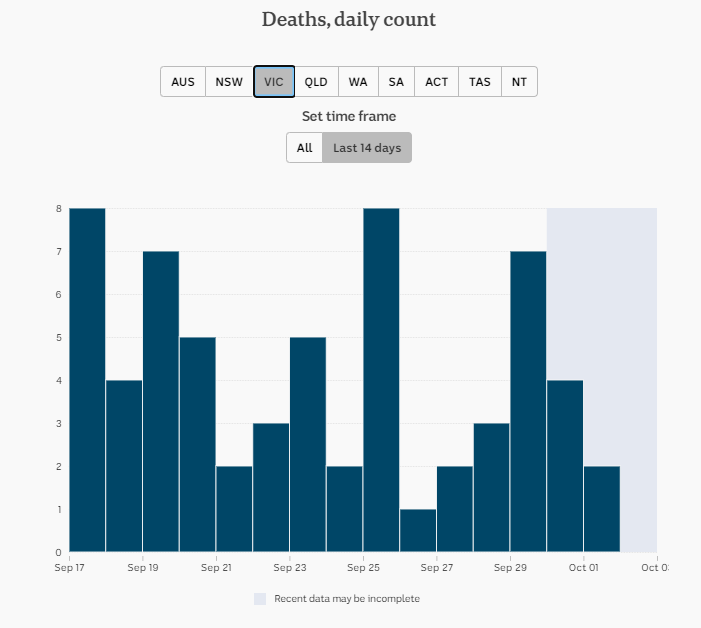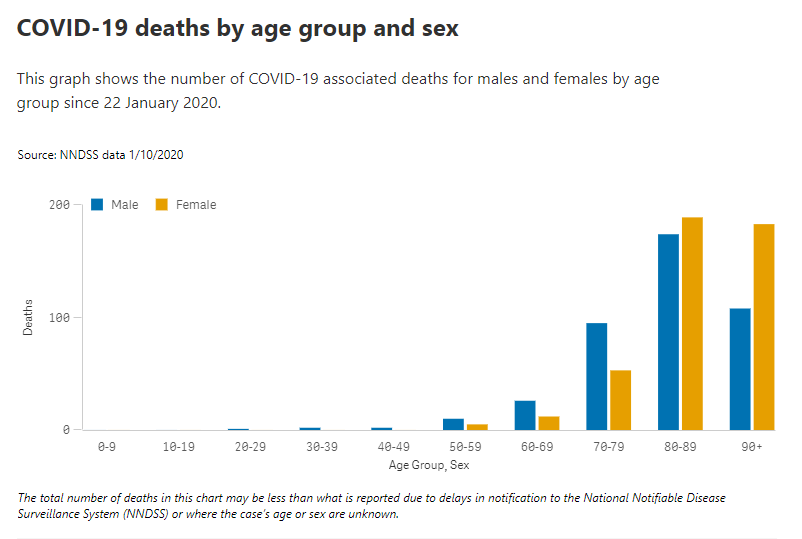29 SEPT QLD
Queensland records another day of zero coronavirus cases as state strives for 'massive stockpile' of PPE equipment
QLD STATE ELECTION WILL HAVE HIGH NUMBERS OF POSTAL VOTES ( NOT A BIG DEAL , THE ELECTORAL COMMISSION AND AUSPOST CAN HANDLE THIS AND EVERY VOTE IS COUNTED , HERE VOTING IS A CITISENS' OBLIGATION - IT'S COMPULSORY AND IF YOU DON'T VOTE YOU ARE FINED ( UNLESS YOU HAVE A VERY GOOD EXCUSE ))
Coronavirus and social distancing means more postal votes in the Queensland election on October 31
CONSEQUENCES
Bar visited by COVID-19 'quarantine-dodgers' lost $100,000 in sales
29 SEPT NT
CONSEQUENCES OF CLOSED BORDERS AND LOCALLY FUNDED UNIVERSITIES BEING INELIGIBLE FOR JOBKEEPER ( SO MUCH FOR LEADING THE NATION OUT OF THE DEEP DARK COVID HOLE BY EDUCATING OUR NEWLY UNEMPLOYED AND INCREASING AUSTRALIA'S BRAINPOWER
Charles Darwin University to cut 77 jobs, cancel 19 courses in merger of vocational and higher education
ANOTHER INTL STUDENT CONTINGUENT AS A COVID TRIAL
70 int. students to be flown to Darwin next month
29 SEPT WA
STATE BORDER SOFTENING
WA eases rules for Victoria, NSW arrivals
WA POLICE CRACKING DOWN ON BREACHERS
Party hosts in police sights in Perth
PORT HEDLAND BULK ORE SHIP CLUSTER
Defence troops sent to Port Hedland as COVID-19 outbreak worsens
<< THIS IS A VERY DANGEROUS SITUATION FOR THE 40k RESIDENTS OF PT AND S.HEDLAND, KARRATHA , BROOME AND LOCAL INDIGENIOUS TOWNSHIPS, THERE IS NO MAJOR HOSPITAL CLOSER THAN DARWIN AND VERY LIMITED MEDICAL FACILITIES IN THE PILBARA & HAMMERSLEY RANGE REGIONS
IT'S A 4 HOUR JET FLIGHT FROM PERTH TO HEDLAND AIRPORT ( THERE ARE NOT USUALLY DIRECT FLIGHTS FROM HEDLAND TO DARWIN ) .
Hedland Health Campus ( WAS BUILT IN 2010 ) AND HAS NO ICU , BUT DOES HAVE AN ISOLATION WARD AND ER.
I EXPECT ANY LOCALS OR CREWMEN WHO NEED INCUBATION WILL BE TRANSFERRED BY RFS OR A RAAF TO EITHER DARWIN OR PERTH ?
https://www.msn.com/en-au/news/australia/defence-troops-sent-to-port-hedland-as-covid-19-outbreak-worsens/ar-BB19w481?ocid=msedgdhp
Queensland records another day of zero coronavirus cases as state strives for 'massive stockpile' of PPE equipment
https://www.msn.com/en-au/news/brisbane/queensland-records-another-day-of-zero-coronavirus-cases-as-state-strives-for-massive-stockpile-of-ppe-equipment/ar-BB19w60F?ocid=msedgdhpQueensland has recorded another day of zero new coronavirus cases, leaving eight cases active across the state.
It has now been 19 days since Queensland last recorded a case that posed a risk of community transmission.
Health Minister Steven Miles said having no new cases registered was "exactly what we hope to see".
"Of course we would continue to encourage anyone with any symptoms to go and get tested," Mr Miles said.
Speaking in Rockhampton, he announced central Queensland would soon be home to a new "distribution hub" to house essential supplies and equipment for hospitals.
"It is a part of our critical supplies stockpile," he said.
"We want to make sure that we have a massive stockpile of all of the equipment that we need right throughout the state and the logistics that will ensure we can distribute that stock into our health services as we need them."
Mr Miles said ideally medical stock would be made in Queensland.
"We can't be reliant on other countries for all of our medical supplies - COVID has proven that," he said.
"We want to create jobs in manufacturing health equipment here in Queensland."
A new 2,175 square metre warehouse to be built in Rockhampton will be able to hold 730 pallets of personal protection equipment (PPE).
"We never want a Queensland Health nurse to ever have to worry ever again if they will have the mask that they want," he said.
"It won't just serve us well during pandemics, it will also serve us well in disasters.
"By having these strategic reserves in important parts of the state ... we can make sure our health services here have sufficient supply without having to rely on getting trucks up from Brisbane."
Central Queensland Hospital and Health Service executive director of medical services Julianne Graham said the new hub was welcome news.
"Our transport lines have been disrupted during COVID ... so the stocks of our PPE have been a concern to staff," Dr Graham said.
She said the region currently only had a three-month supply of "top of the range" masks.
"But that's on normal use and we know that if we get an outbreak like they've had in Victoria that 95 days worth of supply might shrink down considerably," she said.
"So having a warehouse that can stock four times that many masks and four times as many stock of everything we need gives our staff confidence."
Chief Health Officer Jeannette Young said while Queensland has never run out of PPE, it "came close".
"We did have a stockpile, but it wasn't a stockpile we expected to see during this coronavirus pandemic," Dr Young said.
"Knowing that we have this amount of PPE available throughout the state as we go forward is absolutely essential."
QLD STATE ELECTION WILL HAVE HIGH NUMBERS OF POSTAL VOTES ( NOT A BIG DEAL , THE ELECTORAL COMMISSION AND AUSPOST CAN HANDLE THIS AND EVERY VOTE IS COUNTED , HERE VOTING IS A CITISENS' OBLIGATION - IT'S COMPULSORY AND IF YOU DON'T VOTE YOU ARE FINED ( UNLESS YOU HAVE A VERY GOOD EXCUSE ))
Coronavirus and social distancing means more postal votes in the Queensland election on October 31
https://www.msn.com/en-au/news/brisbane/coronavirus-and-social-distancing-means-more-postal-votes-in-the-queensland-election-on-october-31/ar-BB19vvni?ocid=msedgdhpUp to 600,000 people are expected to apply for a postal vote at the upcoming state election after a similar number opted to do so at the local government elections in March.
Electoral Commission of Queensland's (ECQ) assistant electoral commissioner, Wade Lewis, said more than 300,000 people had already submitted postal vote applications since they opened on September 14.
"Very strong demand at the moment — people obviously are thinking about it as a convenient form of voting, particularly in this COVID context that we're delivering the election in," he said.
How do you lodge a postal vote?
The simplest way is to go to the ECQ website and submit an application there, Mr Lewis said.
"That's sent directly to us then and we process that immediately," he said.
Another option is to call the ECQ on 1300 881 665 or print and send a form from the website via email or post.
After you submit an application, a ballot will then be sent to you, which you must then post back to the ECQ.
Applications for postal votes are open until October 16, but voting forms will only be sent out after the closing of candidate nominations in mid-October.
Mr Lewis said if people had issues with accessing the forms, there was help available to assist them.
"If there's any language services that people require, they can request that when they call that number — we have a wonderful provider of translation and interpretative services."
What about political party postal vote sites?
Some people have received emails from their local member with links to request a postal ballot, which might take you to a page owned by that party rather than the ECQ website.
Mr Lewis said these are legitimate and it's a common practice by all the major parties and usually comes along with that party's 'how to vote' material.
"We work very closely with those political parties who then might lodge a form on behalf of electors who choose to provide those details to them, and they then provide that information to us as well," he said.
"If anybody is concerned about that, they can go to our website and apply online directly themselves — they don't need to provide that information to the political parties if they don't want to."
He said applications sent via political parties or candidates could be delayed and that the fastest way to lodge postal votes was directly through the ECQ.
Are there any dodgy sites to avoid?
The ECQ said they had not heard of any scams relating to email registrations or postal voting.
Mr Lewis said they would be closely monitoring all election material, including how-to-vote cards, to ensure nothing was misleading.
Mr Lewis said all election materials must include who authorised it.
"Stop and consider the source of the information that you've received," he said.
It's important to make sure it has been authorised by the political participants in the election.
"If there are any concerns about material floating around in the election that they don't think is properly authorised or that does concern people then certainly people again can contact us."
How could postal votes affect the election?
The ECQ said a high volume of postal votes would slow down the final vote count.
Mr Lewis said people must have completed the ballot by 6pm on October 31 and postal votes would be accepted by the ECQ until November 10.
"We really encourage people to apply as soon as possible, and get it back to us absolutely as soon as possible," he said.
"Given these large numbers of postal votes as well, it does potentially slow down the ability to declare results quickly."
In the 2017 state election, 300,000 votes were cast through the post.
ECQ commissioner Pat Vidgen told the ABC it was 13 days after the 2017 election that the final result was declared.
What about pre-poll voting?
Mr Lewis urged people to remember about voting in person, either on the day or earlier at pre-poll centres.
"If you're able to vote in person that's probably a better option — we're going to have more early voting centres around than ever before and we'll be open for longer as well," he said.
"It'll be fast, it'll be quick, it'll be safe to vote in person."
CONSEQUENCES
Bar visited by COVID-19 'quarantine-dodgers' lost $100,000 in sales
https://www.msn.com/en-au/news/australia/bar-visited-by-covid-19-quarantine-dodgers-lost-100-000-in-sales/ar-BB19wZ9r?ocid=msedgdhpThe owner of a bar attended by one of Queensland's accused quarantine dodgers claims she has cost his business $100,000.
Olivia Muranga attended Cowch Bar in Brisbane's Southbank the day after having a coronavirus test in June when she fell sick following her trip to Melbourne.
The 20-year-old along with Diana Lasu, 21, and Haja Timbo, 21, are accused of lying to authorities about where they had been on return to Queensland.
'That month of August, sales probably got affected, probably about $100,000 down,' Cowch Bar owner Arif Mendes told A Current Affair. 'It was very, very tough.'
Mr Mendes said he was forced to send five staff to isolate for two weeks after working on the day of Ms Muranga's visit, while another 15 required tests.
'So that was pretty tough for all of them trying to support them during that period - not only financially but with their mental health,' he said.
Mr Mendes said furious patrons hurled abuse at him following Ms Muranga's visit to his bar.
'We had customers calling, mad at us, saying "hey, why didn't you tell us?" And there were people around us saying "were you there Arif? Don't come near us, don't go your local gym",' he said.
Both Ms Muranga and Ms Lasu were diagnosed with COVID-19 after allegedly ignoring isolation orders and spending eight days in the public while infected.
Ms Timbo tested negative for coronavirus, while the 22-year-old sister of one of the infected pair turned in a positive test result.
Authorities believed a man contracted the virus when he ate at a Sunnybank restaurant, also attended by one woman two days after her arrival in Brisbane.
His wife - who worked in a nursing home - later also tested positive.
Genomic testing was done in August to determine whether there was a link between the cluster sparked by the women from Logan, south of Brisbane, and one involving people connected to a Brisbane youth detention centre staff member who also tested positive.
Queensland's chief health officer Jeannette Young said last month the clusters were of the same virus strain although there was a 'missing link' between the two.
Health Minister Steven Miles later said the testing hadn't proved a solid link between the two.The travelling trio appeared in Brisbane Magistrates Court on Monday charged with one count of fraud and one of providing false or misleading documents.
They are facing up to five years in prison and a $13,000 fine if convicted.
The three women allegedly gave an emergency officer a Queensland border pass that contained false information stating they had not been in a COVID-19 hotspot in the previous 14 days, according to court documents.
They are also charged with fraud for allegedly dishonestly gaining a benefit of avoiding the mandatory 14 day self-quarantine at their own expense.
Lasu and Muranga's matters have been adjourned to October 28.
Timbo's case is listed again for October 21.
The three will not be required to appear in court if represented by their solicitors.
29 SEPT NT
CONSEQUENCES OF CLOSED BORDERS AND LOCALLY FUNDED UNIVERSITIES BEING INELIGIBLE FOR JOBKEEPER ( SO MUCH FOR LEADING THE NATION OUT OF THE DEEP DARK COVID HOLE BY EDUCATING OUR NEWLY UNEMPLOYED AND INCREASING AUSTRALIA'S BRAINPOWER
Charles Darwin University to cut 77 jobs, cancel 19 courses in merger of vocational and higher education
https://www.msn.com/en-au/news/australia/charles-darwin-university-to-cut-77-jobs-cancel-19-courses-in-merger-of-vocational-and-higher-education/ar-BB19wwK9?ocid=msedgdhpCharles Darwin University has revealed plans to cut 77 jobs — 5 per cent of its workforce — in a merger of vocational and higher education (VET) that could save the institution $10 million.
Staff at CDU were told about the proposed change on Tuesday afternoon, including a plan to cut 19 VET courses.
The scrapped courses include certificates in community night patrol, hospitality, hairdressing and business administration.
The university's deputy vice-chancellor Meredith Parry said two independent reports had found the VET structure was "financially unsustainable".
"This will be a difficult time for many at CDU," Ms Parry said in a statement.
"I am acutely aware that losing a position in a national market that could see up to 21,000 university sector jobs go by the end of the year is confronting, and comprehensive staff support measures have been put in place for staff and their families."
Ms Parry said some of the VET courses being cut have no current enrolments, but ongoing students would have an option to abandon or continue their studies.
A drop in funding and VET enrolments along with challenges in delivering VET courses remotely were also to blame, Ms Parry said.
In July last year, CDU's vice-chancellor Simon Maddocks said a university restructure would result in close to 100 job losses.
Professor Maddocks said the university was facing an unprecedent financial challenge and flagged potential changes to higher education and vocational education course offerings.
The university had already shifted its focus to growing international student numbers.
On Monday, the NT Government confirmed an agreement with the Federal Government and CDU was in place to bring 70 international students to Darwin in late October.
Ms Parry said the proposal for the merger of VET would go through a staff consultation process until October 18.
ANOTHER INTL STUDENT CONTINGUENT AS A COVID TRIAL
70 int. students to be flown to Darwin next month
https://www.msn.com/en-au/news/australia/70-int-students-to-be-flown-to-darwin-next-month/vi-BB19vLk5?ocid=msedgdhpGiven the Territory's low record of COVID-19 cases, the Territory's Chief Health Officer has signed off on the plan
29 SEPT WA
STATE BORDER SOFTENING
WA eases rules for Victoria, NSW arrivals
https://www.msn.com/en-au/news/australia/wa-eases-rules-for-victoria-nsw-arrivals/ar-BB19wp2Y?ocid=msedgdhpWestern Australia will ease restrictions for people arriving from Victoria and NSW as the nation's COVID-19 case numbers continue to fall.
From next Monday, Victorian arrivals - who remain subject to tight exemption criteria - will no longer be required to enter hotel quarantine at their own expense.
They will instead be allowed to self-isolate at a suitable premise for 14 days.
People in NSW will also no longer be subject to tighter exemption criteria than those in other states.
"This is a positive step forward for our nation," Premier Mark McGowan said on Tuesday.
"We can make these adjustments to our border controls because of the positive results we have recently seen over east."
Victoria recorded 10 new cases and seven deaths on Tuesday, while two new cases were recorded in NSW.
Entry to WA from Victoria will remain limited to transport or freight and logistics workers, some politicians and military personnel and health workers.
They will continue to be tested upon arrival and on day 11 of their quarantine period.
Mr McGowan says he is still not prepared to set a date for reopening the hard interstate borders despite the continued decline in cases.
"We're not going to do so until we're completely sure we get the health advice that is completely safe," he said.
He confirmed the health advice remained that the hard borders should not reopen until the eastern states recorded 28 days of zero community transmission.
There has been no community spread in WA for almost six months.
The government has also launched a new G2G Now app allowing people in quarantine to check in and provide police with their location.
Mr McGowan says it will reduce the need for physical police checks and deliver certainty as a greater number of people enter self-quarantine.
WA POLICE CRACKING DOWN ON BREACHERS
Party hosts in police sights in Perth
https://www.msn.com/en-au/news/australia/party-hosts-in-police-sights-in-perth/ar-BB19uRDY?ocid=msedgdhpPerth revellers have been issued a warning ahead of the festive season after police had to deal with allegedly out-of-control parties on the weekend.
Police video appeared to show vandalism and violence taking place in the city last weekend.
"I've just never experienced anything like it in my life, it was just out of control," one witness said.One gathering at the North Perth Town Hall claimed it booked space for an art exhibition, but the riot squad was called in when things grew ugly.
Police also broke up a 16th birthday party last night after multiple complaints.
Ahead of the Christmas season, police have warned that party hosts or their parents can be held liable for the actions of their guests – including gatecrashers.
That includes any injuries, property damage or excessive alcohol consumption.
Police have the power to issue move-on notices and to charge those who refuse.
A party host charged with organising an out-of-control gathering could face fines of up to $12,000 and could also be billed for the cost of the police call-out.
PORT HEDLAND BULK ORE SHIP CLUSTER
Defence troops sent to Port Hedland as COVID-19 outbreak worsens
https://www.msn.com/en-au/news/australia/17-covid-19-cases-linked-to-port-hedland-ship/vi-BB19vSWV?ocid=msedgdhpThe Australian Defence Force is sending troops to Port Hedland in Western Australia's north to manage the outbreak of COVID-19 that arrived in the Pilbara on board iron ore bulk carrier Patricia Oldendorff.
On Monday eight more crew of the Patricia Oldendorff, the vessel sitting off the Pilbara in Western Australia, tested positive to COVID-19.
This meant Western Australia recorded more than Victoria's five new cases on Monday.
The eight new cases are in hotel quarantine in Port Hedland. The total confirmed cases associated with the vessel is now 17. Seven of these are still on the ship as part of the essential crew, while 10 are in hotel quarantine.
Daily cleaning of the vessel continues.
All crew members are in good spirits and have been able to contact family at home, a health department spokesperson said.
Crew had been provided access to culturally appropriate food by a Filipino chef.
Australian Medical Association WA president Dr Andrew Miller warned the state's regional health services could not cope with a bigger outbreak.
He said it was not the first ship the state government had dealt with, but this was the first time sick people had been outside the metropolitan area where the major hospitals were nearby.
"We are into new territory here," he said.
If any of the crew became critically unwell this would pose more challenges. He said regional areas were very vulnerable.
Some of the doctors in the town were not confident the health facilities there would be able to cope with critically ill patients with the highly contagious illness.
Dr Miller said the regional hospitals were tiny and had limited capacity to provide proper intensive care.
"It will be a disaster if COVID spreads into regional communities because that's what's happening all around the world," Dr Miller said.
"More and more and more of the ships that turn up in Western Australia will have COVID on them."
https://www.msn.com/en-au/news/world/australia-sends-troops-to-help-contain-virus-on-ore-ship-near-port-hedland/ar-BB19vVEE?ocid=msedgdhpAustralian defence personnel are being deployed to Port Hedland, one of the world's largest iron ore loading ports, to help contain a coronavirus outbreak on a bulk carrier that last changed crews in the major seafaring city of Manila.
Seventeen of the 21-crew members of the carrier have tested positive for the virus, ship owner Oldendorff Carriers said in a statement.
Ten of the infected crew have been moved to hotel quarantine while seven infected workers remain on board as part of an 11-person crew, authorities said.
Oldendorff said that the Manila crew change on Sept. 5 complied with all protocols.
"All crew members tested negative for the virus before leaving the Philippines," Oldendorff said.The ship, which was scheduled to collect manganese ore which is used in steel production, is anchored off Port Hedland on Australia's northwest coast.
Western Australia state contained the virus early in the pandemic by closing its international and domestic borders. It now bars cruise ship arrivals but allows export carriers and limited international air arrivals. All international arrivals in Australia face mandatory 14-day hotel quarantine.
Up to 10 Australian Defence Force (ADF) personnel were expected to be deployed to Port Hedland after a request for assistance from the state government, an ADF spokesman said in a statement.
12 of the 17 cases linked to a bulk carrier off Port Hedland are in hotel quarantine
<< THIS IS A VERY DANGEROUS SITUATION FOR THE 40k RESIDENTS OF PT AND S.HEDLAND, KARRATHA , BROOME AND LOCAL INDIGENIOUS TOWNSHIPS, THERE IS NO MAJOR HOSPITAL CLOSER THAN DARWIN AND VERY LIMITED MEDICAL FACILITIES IN THE PILBARA & HAMMERSLEY RANGE REGIONS
IT'S A 4 HOUR JET FLIGHT FROM PERTH TO HEDLAND AIRPORT ( THERE ARE NOT USUALLY DIRECT FLIGHTS FROM HEDLAND TO DARWIN ) .
Hedland Health Campus ( WAS BUILT IN 2010 ) AND HAS NO ICU , BUT DOES HAVE AN ISOLATION WARD AND ER.
I EXPECT ANY LOCALS OR CREWMEN WHO NEED INCUBATION WILL BE TRANSFERRED BY RFS OR A RAAF TO EITHER DARWIN OR PERTH ?
https://www.msn.com/en-au/news/australia/defence-troops-sent-to-port-hedland-as-covid-19-outbreak-worsens/ar-BB19w481?ocid=msedgdhp


